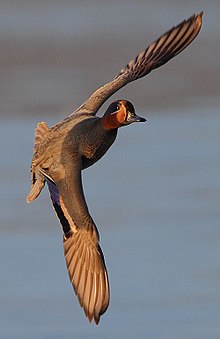Common teal
| Eurasian teal | |
|---|---|
 |
|
| Male in flight | |
| Scientific classification | |
| Kingdom: | Animalia |
| Phylum: | Chordata |
| Class: | Aves |
| Superorder: | Galloanserae |
| Order: | Anseriformes |
| Family: | Anatidae |
| Subfamily: | Anatinae |
| Genus: | Anas |
| Species: | A. crecca |
| Binomial name | |
|
Anas crecca Linnaeus, 1758 |
|
 |
|
| Range of A. crecca Breeding range Year-round range Wintering range | |
| Synonyms | |
|
Anas crecca crecca Linnaeus, 1758 |
|
Anas crecca crecca Linnaeus, 1758
Anas crecca nimia Friedmann, 1948
The Eurasian teal or common teal (Anas crecca) is a common and widespread duck which breeds in temperate Eurasia and migrates south in winter. The Eurasian teal is often called simply the teal due to being the only one of these small dabbling ducks in much of its range. The bird gives its name to the blue-green colour teal.
It is a highly gregarious duck outside the breeding season and can form large flocks. It is commonly found in sheltered wetlands and feeds on seeds and aquatic invertebrates. The North American green-winged teal (A. carolinensis) was formerly (and sometimes is still) considered a subspecies of A. crecca.
The Eurasian teal is the smallest extant dabbling duck at 20–30 cm (7.9–11.8 in) length and with an average weight of 340 g (12 oz) in drake (males) and 320 g (11 oz) in hens (females). The wings are 17.5–20.4 cm (6.9–8.0 in) long, yielding a wingspan of 53–59 cm (21–23 in). The bill measures 3.2–4 cm (1.3–1.6 in) in length, and the tarsus 2.8–3.4 cm (1.1–1.3 in).
From a distance, the drakes in nuptial plumage appear grey, with a dark head, a yellowish behind, and a white stripe running along the flanks. Their head and upper neck is chestnut, with a wide and iridescent dark green patch of half-moon- or teardrop-shape that starts immediately before the eye and arcs to the upper hindneck. The patch is bordered with thin yellowish-white lines, and a single line of that colour extends from the patch's forward end, curving along the base of the bill. The breast is buff with small round brown spots. The center of the belly is white, and the rest of the body plumage is mostly white with thin and dense blackish vermiculations, appearing medium grey even at a short distance. The outer scapular feathers are white, with a black border to the outer vanes, and form the white side-stripe when the bird is in resting position. The primary remiges are dark greyish brown; the speculum feathers are iridescent blackish-green with white tips, and form the speculum together with the yellowish-white tips of the larger upperwing coverts (which are otherwise grey). The underwing is whitish, with grey remiges, dense dark spotting on the inner coverts and a dark leading edge. The tail and tail coverts are black, with a bright yellowish-buff triangular patch in the center of the coverts at each side.
...
Wikipedia

